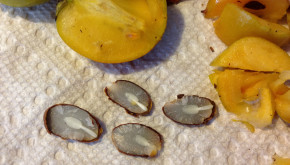
Guest Writer: Mary Hightower, Cooperative Extension Service, U of Arkansas System Division of Agriculture, [email protected]
Do knives, spoons in seeds and wooly bear stripes translate into an accurate winter forecast?
Last year, the majority of persimmon seeds found by Extension personnel had spoon shapes, indicating lots of wet, heavy snow. The Christmas 2012 blizzard and the record-setting May 2013 snow seems to bear out the prediction divined by the seeds.
This year, the majority of seeds found in Faulkner, Lonoke, Perry and Pulaski counties in Central Arkansas are telling of a repeat of the winter of 2012-2013.
However, Berni Kurz, Washington County extension staff chair for the University of Arkansas System Division of Agriculture said one of the persimmons he found “looked like a knife to me.”
North of the border, Patrick Byers, horticulture specialist, University of Missouri Extension, collected fruit from persimmon trees in Lawrence, Stone, Wright and Webster counties. Byers found 21 percent of the seeds had a knife shape, 29 percent had a fork shape and 50 percent had a spoon shape. (See the full story at http://southwestregionnewsservice.blogspot.com/2013/10/persimmon-seeds-predict-colder-winter.html)
“Lots of predictions are being made for the upcoming winter,” said John Jennings, professor-forage, for the University of Arkansas System Division of Agriculture. He’s collecting “old-timer” weather predictions for the coming winter from colleagues. His assessment of persimmon seeds found just north of the Missouri border had “spoons inside, instead of forks other utensils.”
While he was at the university farm in Fayetteville, he came across a solid brown woolly bear caterpillar. Folk wisdom says that “the wider the brown stripe, the milder the winter,” Jennings said. “That should mean a mild winter.”
How did that spoon get there?
The utensil shape the seed-splitter is seeing is the embryo, which “would become a new persimmon tree if the seed was left to germinate,” said Vic Ford, director of the Southwest Research and Extension Center at Hope. “The flat parts are the primary leaves or cotyledons. The orientation of the embryo inside the seed will cause the spoon, fork, or knife shape to appear.”
So is the orientation weather related? Ford said it’s just an old Ozark folk tale.
What about those stripes?
Gus Lorenz, extension entomologist for the University of Arkansas System Division of Agriculture, said the woolly bear’s stripe relates to polymorphism -- or a variety of forms within a creature.
“’Polymorphism’ is common in nature; it is related to biodiversity, genetic variation and adaptation,” he said. Selection, whether natural or artificial, changes the frequency of morphs within a population; this occurs when morphs reproduce with different degrees of success.”
In this case predominance of the woolly bears “is probably preferential survival based on existing environmental conditions which favor that stripe width,” Lorenz said.
NOAA’s Climate Prediction Center (CPC) forecast for October, November and December calls for equal chances of above, below or normal temperatures and precipitation.
(See: www.cpc.ncep.noaa.gov/products/predictions/long_range/seasonal.php?lead=1).
The CPC’s long-range forecast shows temperatures to be a little on the mild side for January, February and March 2014. There are equal chances for above, at or below normal precipitation for the same period.
(See: www.cpc.ncep.noaa.gov/products/predictions/long_range/seasonal.php?lead=4).
Other folkways for winter prediction, collected by Jennings:
· “For every day of fog in August, a day of snowfall in winter.”
· “If it thunders in February, it will snow in March.”
· “Lots of nuts - a hard winter.”
· “Hornets’ nests predict snow depth. They build above where the snow will be.”
· “Thunder in February means a frost on that day in April.”
· “The spiders are trying to take up residence in side my house. My daddy always said that was a sign of a bad winter.”
· “Old timers in Sharp County report that squirrels are building nests lower to ground level in trees which is a sign of a harsh winter.”

